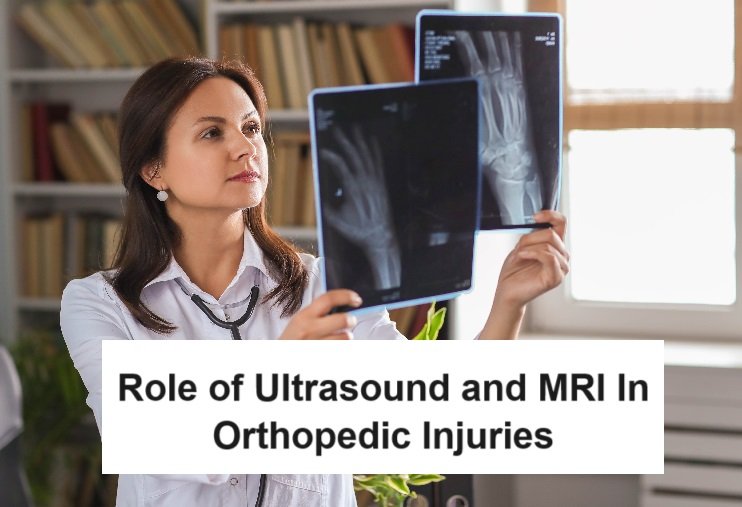Do you know why a doctor uses Ultrasound and MRI? Or, when one is chosen over another? This article discusses these questions in detail, along with other considerations with respect to orthopedic injuries.
Do you know why a doctor uses Ultrasound and MRI? Or, when one is chosen over another? Let’s understand why we need these tests and their role in diagnosing
Usage of Ultrasound and MRI In Orthopedic Injuries
Let’s understand why we need these tests and their role in diagnosing orthopedic injuries.
What Is an Ultrasound Test?
Ultrasound, also known as Sonography, is a medical imaging technique. This is used to discover problems, conditions or injuries related to soft tissues. However, an ultrasound test is not effective for bones and body parts with air cavities like the lungs.
An ultrasound uses sound frequencies to create images of the internal body parts. This is a non-invasive diagnostic procedure.
What Is an MRI Test?
An MRI, or Magnetic Resonance Imaging, is another imaging test. Under this diagnostic procedure, radio waves and a strong magnetic field are deployed to create images of the soft tissues.
Like Ultrasound, an MRI test is also more appropriate for injuries in soft tissue rather than bones.
What Is the Difference Between Ultrasound And MRI?
Ultrasound is effective at producing detailed images of soft tissue. Such soft tissue must not be deep within the skin.
However, an MRI test can image soft tissue in detail no matter how deep it lies within the body or underneath the skin.
For a practical understanding, an ultrasound examination of the knee joint will only offer details of the soft tissue outside, around the joint, which is just under the skin but not too deep within the knee joint.
However, an MRI test will provide a detailed imaging experience of all the crucial components of the knee, highlighting injured parts.
An orthopedic specialist might recommend an ultrasound test for the shallow examination of a joint and the soft tissue around it. And, if everything looks fine, the same doctor might go with an MRI test for further diagnosis. This can be a scenario in orthopedic diagnostics, highlighting the unique importance of both tests.
Key Takeaways (Role in Orthopedics)
So, Ultrasound and MRI help diagnose orthopedic injuries related to soft tissue such as muscles, ligaments, tendons, cartilage, menisci, synovium, etc. Ultrasound is good for shallow examination while MRI offers detailed images of soft tissue lying even deep within the skin.
Thus, their role in orthopedic injuries is immense.
Other Diagnostic Tests for Musculoskeletal Injuries
Apart from Ultrasound and MRI, other diagnostic tests for orthopedic injuries are,
- X-rays
- CT scans
An X-ray is only done to examine fractures and dislocations or to rule out the mere possibility.
A CT scan is another imaging test. It can detect injuries or diseases related to bony as well as soft-tissue parts. It offers more detailed imaging of bones than an X-ray test.
Cost of Ultrasound and MRI Tests
Ultrasound costs less than MRI. Besides, the latter might not be as much available as the former. Ultrasound facilities are more easily available than those for MRI tests.
Orthopedic Injuries
Orthopedic injuries are damage due to accidents in bones and soft tissue such as muscles, ligaments, tendons, bursae, menisci, synovium, articular cartilage, etc.
For example, an autoimmune inflammatory disorder like Rheumatoid Arthritis can cause chronic joint pain and stiffness without external traumas.
Other conditions are osteoarthritis (OA) or septic arthritis.
Besides, sports injuries are the most common orthopedic injuries. These injuries happen during sports activities. The most prevalent form of sports injuries are ACL injuries.
ACL injuries are related to the Anterior Cruciate Ligament. This ligament is found in the middle of the knee. A ligament connects one bone to another. It is usually a band-like structure. Because of too much stretching and unbearable stress, it often gets injured.
Sometimes, because of moves like pivoting and cutting, the knee ligament, especially the ACL, gets completely torn. In this condition, surgery is required such as ACL reconstruction surgery.
Most ACL reconstruction surgery is carried out arthroscopically, which is a minimally invasive procedure; surgery will be done with special tube-like tools with a few small holes or incision in the front of the knee.
If you want to meet with the best doctor for sports injuries or ACL injuries, visit the following link: best sports injury doctor in Delhi.
People at High Risk of Orthopedic Injuries
Certain people are more susceptible to orthopedic injuries than others. These people are athletes, labourers, field workers, individuals with osteoporotic bones and joints, etc.
However, an accident can happen to any human being, for example, falling down stairs and ending up with fractures or getting involved in a collision on the road while commuting.
Unsupervised exercise at the GYM without proper guidance can also culminate in orthopedic injuries.
The most common orthopedic injuries are:
- Fractures
- Dislocations
- Ligament Tears
- Muscle and Tendon Damage
- Damage to Bursae
- Meniscus Tears
- Cartilage Damage
If you are an athlete, consider the following preventive measures to keep orthopedic injuries at bay:
- Be mindful while actively engaging in sports;
- Take adequate sleep before participating in sports. Sleep deprivation will result in poor concentration. Poor focus is often associated with a high risk of sports injuries;
- Keep your body hydrated;
- Learn proper techniques to cut or pivot;
- Anticipate potential injuries and take preventive calls in advance. In other words, avoid foreseeable accidents;
- Wear protective gear;
- Don’t overdo yourself during weight training or otherwise;
- Use proper footwear to minimise foot and ankle-related injuries;
- Make sure you eat healthy and exercise regularly for overall body and core muscle strengthening; and,
- Rule out the possibility of osteoporosis.
If you have sustained an injury during sports, apply ice and compress the affected part to prevent too much swelling and other inflammatory effects.
Furthermore, if the injury has occurred anywhere in the lower extremity, i.e., the knee, the leg, the ankle or the foot, elevation also reduces inflammation. Just elevate the injured part after compression above the heart level while lying on the back.
These little first-aid tips will help reduce inflammation after an injury. However, don’t forget to consult a doctor if the pain persists!
Conclusion
Ultrasound and MRI both help diagnose soft-tissue injuries. These imaging tests help orthopedic doctors diagnose, or discover, injuries related to ligaments, tendons, muscles, bursae, synovium, etc.
Whereas an MRI test can offer an in-depth examination of soft tissue, no matter how deep it lies within the skin, an Ultrasound test can only offer in-detail images of soft tissue around a joint not too deep underneath the skin.
For a thorough examination, an orthopedic doctor will always choose MRI over Ultrasound. To meet with the best orthopedic doctor, visit the following link: top 10 orthopedic doctors in India.



